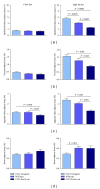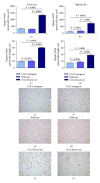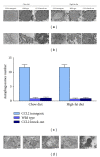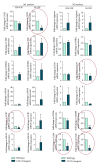Ubiquitous transgenic overexpression of C-C chemokine ligand 2: a model to assess the combined effect of high energy intake and continuous low-grade inflammation
- PMID: 24453432
- PMCID: PMC3876923
- DOI: 10.1155/2013/953841
Ubiquitous transgenic overexpression of C-C chemokine ligand 2: a model to assess the combined effect of high energy intake and continuous low-grade inflammation
Abstract
Excessive energy management leads to low-grade, chronic inflammation, which is a significant factor predicting noncommunicable diseases. In turn, inflammation, oxidation, and metabolism are associated with the course of these diseases; mitochondrial dysfunction seems to be at the crossroads of mutual relationships. The migration of immune cells during inflammation is governed by the interaction between chemokines and chemokine receptors. Chemokines, especially C-C-chemokine ligand 2 (CCL2), have a variety of additional functions that are involved in the maintenance of normal metabolism. It is our hypothesis that a ubiquitous and continuous secretion of CCL2 may represent an animal model of low-grade chronic inflammation that, in the presence of an energy surplus, could help to ascertain the afore-mentioned relationships and/or to search for specific therapeutic approaches. Here, we present preliminary data on a mouse model created by using targeted gene knock-in technology to integrate an additional copy of the CCl2 gene in the Gt(ROSA)26Sor locus of the mouse genome via homologous recombination in embryonic stem cells. Short-term dietary manipulations were assessed and the findings include metabolic disturbances, premature death, and the manipulation of macrophage plasticity and autophagy. These results raise a number of mechanistic questions for future study.
Figures











References
-
- Cecchini M, Sassi F, Lauer JA, Lee YY, Guajardo-Barron V, Chisholm D. Tackling of unhealthy diets, physical inactivity, and obesity: Health effects and cost-effectiveness. The Lancet. 2010;376(9754):1775–1784. - PubMed
-
- Strong K, Mathers C, Leeder S, Beaglehole R. Preventing chronic diseases: how many lives can we save? The Lancet. 2005;366(9496):1578–1582. - PubMed
-
- Joven J, Rull A, Rodríguez-Gallego E, et al. Multifunctional targets of dietary polyphenols in disease: a case for the chemokine network and energy metabolism. Food and Chemical Toxicology. 2012;51:267–279. - PubMed
-
- Hotamisligil GS. Inflammation and metabolic disorders. Nature. 2006;444(7121):860–867. - PubMed
Publication types
MeSH terms
Substances
LinkOut - more resources
Full Text Sources
Other Literature Sources
Molecular Biology Databases
Miscellaneous

